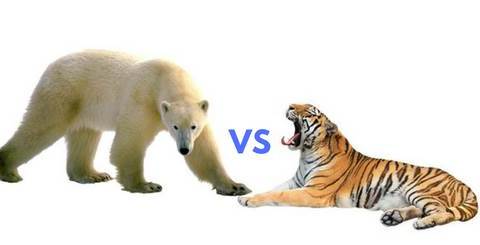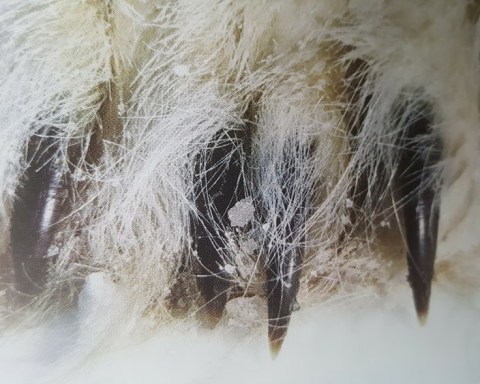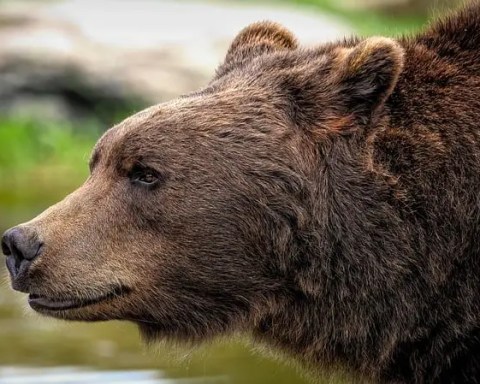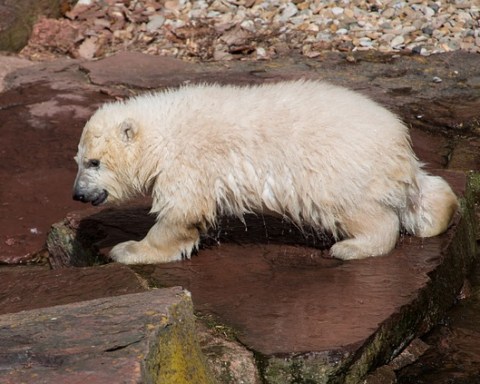Polar bears (Ursus maritimus) are unquestionably resilient to the arctic environment. Their adaptation to stay warm in an unbelievably cold temperature is something that makes them matchless in the mammalian world. Thanks to its insulating ability, white color, and dense fur that not only makes the bear warm but also camouflages her in the arctic ice. The thick and fuzzy jacket prevents the polar bear from catching cold in the icy water.
How Do Polar Bears Stay Warm?
The insulating phenomenon of polar bears is not as simple but scientists are putting their best to reason out how polar bears can stay warm in such a freezing temperature of the Arctic Circle. Latest findings suggest that polar bear’s hairs are likely to perform the functions of a heat pipeline. According to scientists as the sunlight touches the tiny hair it travels to the end and enters the polar bear’s skin. They believe that the bear’s hair seems like fiber-optic cable in function.
Thanks to its insulating ability, white color, and dense fur that not only makes the bear warm–it also camouflages her in the arctic ice
There is a scientific belief that the polar bear’s coat serves as a protector in that it attempts to bring warm particles of the air into tiny pores. However the modern studies suggest that the pelt also performs another insulating function. This function is performed within the polar bear’s coat. Polar bear’s skin emits the body heat as infrared light which in turn bounces around within the coat just like a table tennis ball. The infrared rays are thought to move back and forth between the hairs. According to the research the bear’s hair neither absorbs light nor does it scatter light absolutely. In fact they partially perform both.
Biologists maintain that the density of hairs is what actually defines the reflection of light. If the hair density is greater the light reflects many times with some of it returns back to the skin.
Read More: Polar Bear Physical Features
How Do Polar Bears Stay Warm in the cold?
Polar bears appear to make themselves warm via three kinds of heat transfer: convection, conduction, and thermal radiation. Conduction is the process in which the heat waves travel through the medium but the materials do not move whereas in convection the movement is primarily caused within a fluid. However the most useful (of these) is thought to be the thermal radiation.
Scientists have long believed that the hot air traps inside the polar bear’s body in the same way as it does in some housing insulations. The coat performs the given function.
Thermal Radiation
Scientists seem to count on thermal radiation as compared to convection or conduction. According to them polar bears use thermal radiation to keep warm in the cold. In thermal radiation the energy is discharged in the form of electromagnetic waves. Human’s skin gets heated in the similar fashion. Similarly if someone wears a shiny jacket the heat waves radiate from the human body is likely to smack the jacket and scatter while keeping the heat inside.
All living organisms release heat which can be seen through night-vision goggles. The goggles are able to detect the infrared radiation but polar bears are so perfectly insulated that no such radiation or heat is observed even through goggles. The heat is trapped 100% inside the bear’s body. The polar bear’s pelt appears to possess the same temperature as its surroundings.
Scientists finally conclude that the polar bear fur partially absorbs heat radiation and partially scatters it. The heat waves are thought to travel in different directions after being scattered and re-emitted. The sunlight doesn’t believe to keep bears warm in fact it is the scattering of light off the fur that warms the animal. “The more animal reflects the [infrared] light, the more efficient the insulation”, American Institute of Physics.
Read More: How Many Layers of Fur Do Polar Bears have?
Heat Loss and Heat Regulation—During Swimming
The latissimus dorsi are the muscle sheets which lies at the mid-central back of the body. These sheets play a significant role in the heat regulation. During swimming the heat is discharged through conduction whereas on land the heat is primarily lost by convection. Above the surface polar bears often lie on the back and wave their legs in the air to cool her body. In order to stable body temperature bears will drink water in excess.
Polar bears may also change to sternal posture in which they move their feet backwards or sometimes curling paws around their body. By so doing bears can reduce their temperature from 36o C to 27o C.
On the icy surface, polar bears spread their legs so that their body releases heat. On land when polar bears are overheated they just dig small depressions and relax into it.
The heat loss during swimming is extremely important because the bear generates heat in the submerged water which in turn is probably neutralized by the heat loss.
While polar bear’s fur shows outstanding insulating property the pelt seems to have poor insulative ability. They will maintain stable body temperature by bringing change in subdermal vascularization and other adaptive mechanisms in order to compete with the cool environmental conditions. The subcutaneous fat also serves as insulating material. Bears lose additional heat via foot pads and shoulders.
The polar bear’s fur is 55 mm in thickness which is pretty fair insulation. However some of the hairs are rough and they do not insulate heat as effectively. During swimming polar bears lose heat 20 – 25 times faster than in the open air. But in disturbed water the bear is likely to lose heat nearly 50 times that in the air.
The heat loss during swimming is extremely important because the bear generates heat in the submerged water which in turn is probably neutralized by the heat loss. Soon after swimming the bear shakes her body to shed the water from her fur in order to make sure that the pelt insulates properly. Polar bear’s posture and respiration also affects the heat loss phenomena.
Polar bears are highly efficient in finding out numerous biological mechanisms to cope with the heat loss. One such adaptation is that they can cool their external tissues which create an insulating shell and their body goes warm. This is known as regional heterothermy. According to the researchers, white bears (by doing so) prevent the extreme heat loss during swimming in the icy water. The bear must adopt this mechanism on almost regular basis for the melting of arctic ice indeed makes swimming harder and longer.
The peripheral muscles and subcutaneous fat serve as important insulators especially during swimming. Polar bear’s fur doesn’t appear to insulate well in water in fact the bear finds shelter in a windy weather. They will also discharge heat through the thin muscle sheets which are present on the torso. Alongside torso bears also lose heat via snout and footpads. The significant player in the peripheral insulation is the peripheral tissue without which the insulation might never be possible.
During swimming the skin temperature is relatively higher. The heat dissipation often puts check on the polar bear’s ability to engage in physical activities for long periods. For instance bears can hardly perform exercise for more than 15 minutes.
Polar Bear Cubs Insulation and Temperature
Read More: Polar Bear Cub
At birth the polar bear cubs have only 5-mm-long coat and there are only 600 – 700 hairs per square centimeter. They don’t seem to cover with subcutaneous fat nor do the fats surround kidneys. They are not yet prepared to challenge the freezing environment of the Arctic.
Once they attain weight of about 8.5 – 9.5 kilograms they can stable their body temperature 30o C to 0o C with a slight increase in the metabolic rate in temperatures below 10 degree centigrade. However weak polar bear cubs may be as against adults the physiological insulation is good enough to sustain constant temperature while swimming.
During swimming the water temperature ranges from 0 – 2o C but the core body temperature of a cub is stabilized at 38.5o C. If cubs keep walking for as long as 29 minutes their temperature alleviates to 400 C.






